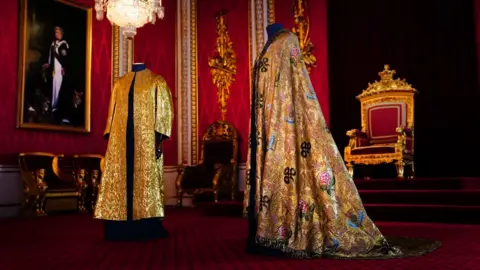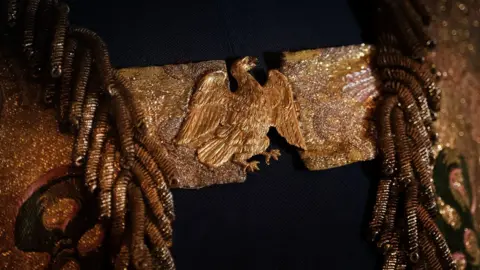King Charles Coronation: What will he wear for the ceremony?
 Victoria Jones
Victoria JonesWe know the date, the time, most of the guest list - and now we know the outfit.
The heavy and priest-like golden robes King Charles III will wear for his Coronation have been revealed.
During the service, the King will put on layer upon layer of glittering vestments, some of which were created for his great-grandfather George V.
Prince William will help during the service by placing a ceremonial robe on his father.
 PA Media
PA MediaFor the crowning, King Charles will be given a long shimmering gold-sleeved coat to wear called the Supertunica.
The robe was created for George V in 1911 and has been worn at successive coronations including by the late Queen Elizabeth II.
It weighs about 2kg (4.4lb), is made of cloth of gold - silk thread wrapped in thin pieces of gold or silver gilt metal - and is embroidered with stylised arabesques and floral motifs.
Layered on top of the Supertunica, there will be a floor-length cloak called the Imperial Mantle, or Robe Royal, which was made for George IV in 1821 - it weighs 3-4kg (6.6-8.8lb).
The mantle, which fastens across the chest with a golden eagle clasp, is inspired by ancient coronation ensembles and its priest-like style is meant to symbolise the divine nature of kingship.
Made of cloth of gold, it is embellished with motifs including fleur-de-lis, as well as imperial eagles, and national floral emblems of red-pink roses, blue thistles and green shamrocks.
It has been worn by previous monarchs including Queen Elizabeth II during her coronation in 1953.
 PA Media
PA MediaThe weight of the ceremonial robes comes on top of the crown which weighs about 2.23kg (nearly 5lbs).
The robes are reminiscent of the coronation ceremony, explained Caroline de Guitaut, deputy surveyor of the King's Works of Art at the Royal Collection Trust.
"They have clearly incredible historic significance, but they're also significant because of the sacred nature of their use during the investiture part of the coronation ceremony," she said.
The garments are usually kept in the Tower of London and form part of the coronation regalia.
It is tradition for recent monarchs to reuse garments, just as King Charles is, but they usually have a new coronation sword belt and glove to be used during the ceremony.
But in a move aimed at making the event more sustainable, the King has decided to reuse the belt and glove worn by his grandfather George VI - the last male monarch.
"It was the King's personal decision", said Ms de Guitaut, adding that the items remain in "remarkable condition".
"And it's in keeping with this idea of sustainability and efficiency to reuse these pieces," she added.
The sword belt from 1937, also known as the Coronation Girdle, is made of embroidered cloth of gold and has a gold buckle stamped with national emblems.
During the investiture, it will be placed around the King's waist, over the Supertunica, and has a gold clip used for briefly attaching the jewelled Sword of Offering, which symbolises being able to decide between good and evil.
Meanwhile, the single coronation glove, also known as the Coronation Gauntlet, will go on King Charles' right hand while he holds the Sovereign's Sceptre with Cross during the crowning.
It is made of white leather and the large cuff is embroidered in the form of national emblems including the Tudor rose, thistle, shamrock, oak leaves and acorns. The back of the hand has an embroidered ducal coronet above the coat of arms of the family of the Dukes of Newcastle.
The garments are usually kept in the Tower of London and form part of the coronation regalia.
 PA Media
PA MediaKing Charles will arrive at Westminster Abbey in George VI's crimson red Robe of State which he will remove for his anointing.
Then for the investiture he will put on a sleeveless white garment called the Colobium Sindonis - Latin for shroud tunic - and will also be given a long, narrow embroidered band of gold silk which goes around the shoulders, known as the Coronation Stole.
At the end of the service, the King will change into George VI's purple Robe of Estate to leave the Abbey.

Read the latest from our royal correspondent Sean Coughlan - sign up here.
